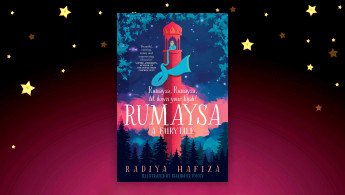Rumaysa: Redefining children's fairytales for the modern Muslim child
Fairytales are an intricate part of reading while growing up. It is rare to find readers who are unfamiliar with the popular stories of Rapunzel, Cinderella, or Sleeping Beauty. The world has seen many animation and movie adaptions of these tales recently. So, what if a Muslim kid growing up anywhere were to pick up a book based on the main characters from these tales, and find themselves reflected in it? Rumaysa by Radiya Hafiza is that book.
A friend of mine, Ayesha Choudhury, first recommended Rumaysa to me, and she called it a book that every Muslim kid that grew in the West would have yearned to read. Choudhury runs an inclusive, diverse indie bookshop called Mirror Me Write in Manchester, UK. Picking up Rumaysa on her recommendation is already one of the best bookish decisions I have made this year.
"Rumaysa is a book that every Muslim kid that grew in the West would have yearned to read"
Starting with a retelling of Rapunzel, Rumaysa tells the story of a young girl, who is stuck in a tower after a wicked witch, Cordelia, kidnaps her from her parents. Unlike Rapunzel – who uses her gorgeous brown (blonde in some retellings) hair, with the help of a dashing young man, to escape the tower – Rumaysa, with her magical abilities, spins a long, golden hijab and escapes her prison tower with the help of her owl friend, Zabina.
Already, with these minute spins, Hafiza accommodates so many remarkable lessons in her retelling. She does not write Rumaysa’s hair out of the story; instead, she shifts the spotlight to her hijab, a tool Rumaysa uses to escape oppression and imprisonment. She also does not write out Rapunzel’s ‘dashing young man, rather, readers see him as a young boy with a magic carpet called Suleiman, who benefits from Rumaysa’s magical powers. Talk about keeping it 100 percent halal.
|
After she escapes from the tower and Cordelia’s evil grip, Rumaysa sets on a quest to find her long-lost parents. Through her journey, readers are introduced to the retellings of two other fairy tales: Cinderella as Cinderayla and Sleeping Beauty as Sleeping Sara. This is perhaps, the most exciting part of this book. Hafiza brings Rumaysa into the world of her Cinderella retelling, to forge a brilliant story of female friendship.
In Hafiza’s retelling, Cinderayla chooses her self-worth and dignity over the supposed love of an arrogant, classist prince – and she does this with the help of her new magical friend, Rumaysa (cue for fairy godmother). With this story, Hafiza further reinforces the value of friendship, helping others and nursing self-belief. The story also discourages bad characters like arrogance and looking down on others because of their appearance or social status – both of which are highly discouraged in Islam.
Lastly, Rumaysa finds her way into the world of Sleeping Sara. Sara is a princess born to King Emad and Queen Shiva. Her parents are unjust rulers who tax their people heavily due to harsh winters and long summers. Before long, an evil named Azra capitalizes on the displeasure of the people to attempt a coup. He puts princess Sara under a sleeping spell and blackmails her parents into abdicating the throne. But we can always count on Rumaysa, our magical hijabi to save Princess Sara, with the help of her friend, Suleiman.
Again, with the minor changes in this story, Hafiza breaks a lot of tables. Unlike the original Sleeping Beauty, a true love's kiss does not save Sara. Instead, both Rumaysa and Suleiman help Sara save herself, and that experience prepares her for her future as a just, strong Queen.
"Rumaysa is a brilliant book that reorients our ideas and images of characters in fairy tales"
In Rumaysa, Cinderayla, and Princess Sara, we see young girls who take charge of their lives and save themselves, albeit with much-needed support from friends (male and female alike) and family. Seeing all these qualities reflected in characters that look like them and have similar names to theirs, is a part of the representation that Muslim kids need in literature today.
In another scene, Hafiza highlights the importance of communication between parents and their children. Suleiman’s parents want him to be adventurous, but he yearns to stay indoors to discover hidden magical items. In this scene, he firmly, but respectfully tells his parents that he wants to follow his dream. He implores them to support him, and his parents listen gently.
Similarly, princess Sara helps her parent discern their injustice to the people after speaking to them, after which they apologise. There is something beautiful in this scene because, in many Muslim homes, mutually respectful conversations between parents and children are not as common as the Deen encourages. Reading a scene like this in books will remind both parents and children that such dialogues can exist.
The cherry on top of this book lies with its ending. Hafiza leaves room for some limitless scope of adventure for our magical hijabi, Rumaysa, and for readers who may want to imagine a longer story for this awe-inspiring character.
Rumaysa is a brilliant book that reorients our ideas and images of characters in fairytales.
Aisha Yusuff is a book reviewer with a focus on African and Muslim literature. Her work can be found on @thatothernigeriangirl as well as in digital magazines like Rewrite London.
Follow her on Twitter: @allthingsaeesha



